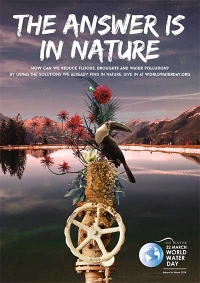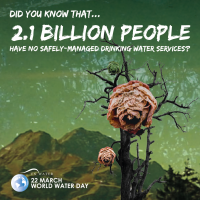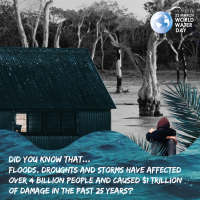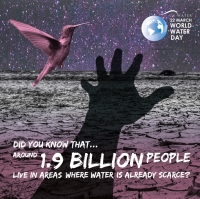Nature For Water - World Water Day

Today is the 25th World Water Day, first observed in 1993 as the United Nations designated day to highlight the importance of freshwater. In December 1992, the UN General Assembly had adopted the resolution by which the 22nd of March was declared as the World Water Day. This year’s theme, ‘Nature for Water’ explores how we can use nature to overcome the water challenges of the 21st century.
The United Nations World Water Development Report released in drought-hit Brasília on the eve of triennial World Water Forum has warned that more than 5 billion people could suffer water shortages by 2050 due to climate change, increased demand and polluted supplies. The comprehensive annual study warns of civilizational conflicts and called for urgent actions to reduce the stress on rivers, lakes, aquifers, wetlands and reservoirs.
The report calls for a new approach termed as ‘conservation agriculture’, which would make greater use of rainwater rather than irrigation and regularize crop rotation to maintain soil cover. It said that positive change in the key agricultural sector is possible if there is a move towards nature-based solutions that rely more on soil and trees.
Environmental damage, together with climate change, is driving the water-related crises we see around the world. Floods, drought and water pollution are all made worse by degraded vegetation, soil, rivers and lakes. The official World Water Day campaign, ‘The answer is in nature’ focuses on the potential of nature-based solutions to solve many of our water challenges.
Planting new forests, reconnecting rivers to floodplains, and restoring wetlands will rebalance the water cycle and improve human health and livelihoods. Approximately 75% of all accessible fresh water in the world comes from forests and the importance of forests for future water security is evident in numerous studies and policy documents. In a reflection of the new reality, the new draft Indian National Forest Policy 2018 proposes climate change mitigation through sustainable forest management.
By using nature-based solutions to help meet the water needs of a growing population, we will contribute to the creation of a circular economy, at the same time as helping to protect the natural environment and reduce pollution - both key targets in Sustainable Development Goal 6, which commits the world to ensuring availability and sustainable management of water and sanitation for all by 2030.
Most nature-based solutions, including in urban landscapes, essentially involve the management of vegetation, soils and wetlands, including rivers and lakes. Nature-based solutions are not a panacea to the critical water-related challenges we face as the global population grows, but they can provide innovative and cost-effective options for supplementing insufficient or ageing water infrastructure.
Water storage via natural wetlands, soil moisture and/or groundwater recharging can be more sustainable and cost-effective than grey infrastructure, such as dams. Pollution from agriculture can be drastically reduced by NBS such as conservation agriculture, which protects soil from erosion, or riparian buffers, strips of land along water courses planted with native trees and shrubs.
The effects of climate change, such as frequent extreme flooding, can be mitigated by a range of nature-based solutions, such as riparian buffers or connecting rivers to floodplains. The application of certain nature-based solutions creates what is known as ‘green infrastructure’: natural or semi-natural systems that give us equivalent or similar benefits to conventional, human-built ‘grey infrastructure’.
Nature-based solutions often produce benefits beyond water-related services. For example, constructed wetlands used for wastewater treatment can provide biomass for energy production, improve biodiversity and create recreational spaces and associated employment.
The most positive message of the UN World Water Development Report 2018 is that the potential savings of a rapid transition to ‘conservation agriculture’ would exceed the projected increase in global demand. Adoption of nature-based solutions can avoid imminent conflict, provide better livelihoods and promote equitable growth. It is important for all stakeholders to adopt nature-based solutions and ensure water security for global peace and prosperity.




Rituraj Phukan
Videos
Videos
Videos
@ignitingmindsmagazine
@IgnitingMindsin
Top Stories
- Dedicated to the Sparrows, Forests and Water
- The United Nations Decade of Ecosystem Restoration
- How technology in agribusiness affects climate change, a concrete solution.
- Restless Youth Seek Climate Action
- Telangana Jagruthi International Youth Leadership Conference 18,19,20th January 2019
- Sports for Climate Action Framework launched at COP24
- COP24: One Week of Misgivings
Videos
Businesses
- Can Home Remedies Increase Your Height.
- Success Comes When We Make Innovation a Habit
- Do You Want to Be a Green Entrepreneur?
- Igniting Minds Official Web Portal Launched in New Delhi.
- Strive To Drive The Life
- Do Mobile Apps Facilitate Small Businessmen?
- Water Conservation, Preservation and Restoration. A Global Engineering Challenge.